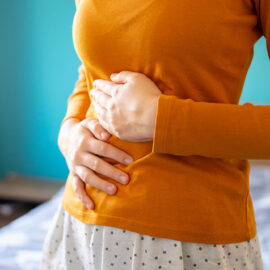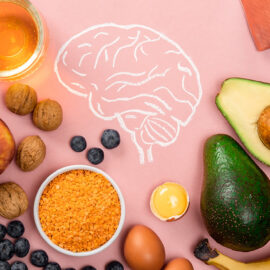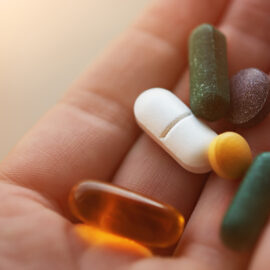Hormones are essential for life as they help to optimize all aspects of health and performance. From growth development and reproduction to metabolism, mood and sleep cycles, hormones play a crucial role in many different processes in the body. While men and women have the same basic hormones, the levels of two of the major sex hormones, estrogen and progesterone, are generally higher for women with a vastly different pattern of production that changes over time and throughout their lifespan. This makes hormonal balance especially critical for women’s health. While this balance can be disrupted in many ways, including the natural fluctuations that occur during puberty and menopause, simple dietary and lifestyle changes can help restore proper levels of hormones.
What are hormones?
Before reviewing the role of female hormones, it’s important for healthcare professionals to have a solid understanding of what hormones are and how they impact the human body. Simply put, hormones are substances made in the body that serve as chemical messengers which affect and manage countless bodily processes. And a single process often involves a chain reaction between several different hormones.1 Once released by glands into the bloodstream, hormones act on various organs and tissues to control and regulate physiological functions, mood, and behavior. Ovaries are a pair of female glands in which eggs form and the female sex hormones, estrogen and progesterone, are made.
Which hormones that have the most profound impact on women, and what are their roles?
Contrary to popular belief, the same sex hormones are produced by both men and women (i.e., estrogen, progesterone, testosterone). However, their production sites, blood concentrations, and interactions with organs and systems are different.2 Females mainly produce estrogen and progesterone, which have the most significant effect on a woman’s health from menstruation to menopause and more. Estrogen and progesterone fluctuate in a cyclic pattern, commonly known as the menstrual cycle. The length of a menstrual cycle is the number of days between the first day of menstrual bleeding of one cycle to the onset of menses, or the start of menstruation, of the next cycle.3 Menstrual cycles typically last for 28 days with most cycle lengths ranging between 25 to 30 days.
According to the Endocrine Society, estrogen is a hormone with three major forms, estradiol, estriol, and estrone, that play a pivotal role in growth and reproductive development in women.4 Estradiol is the strongest of the these three forms and is responsible for maturing and maintaining the reproductive system. During menopause, women have lower levels of estradiol as the ovaries no longer produce it, which ultimately causes the cessation of menstrual cycles. Estriol increases during pregnancy with its primary function being to help the uterus grow and prepares the body for childbirth and breastfeeding. Lastly, estrone is the weakest of the three forms of estrogen and plays a role in a women’s sexual function and reproductive health. It’s also the only form that the body continues to make naturally after menopause. 4
Progesterone’s main function is to prepare the endometrium for the potential of pregnancy after ovulation. If pregnancy does not occur, the endometrium sheds during the menstrual cycle. Conversely, if conception takes place, progesterone increases to support the pregnancy.5
Other hormones that have a significant impact on the reproductive health of women include those produced from the thyroid gland, thyroxine (T4) and triiodothyronine (T3). These hormones are vital for female reproductive system homeostasis and as they regulate the reproductive functions through thyroid hormone receptors.6 the When the levels of this hormone are imbalanced, a women could be impacted in many ways through various life stages. For example, thyroid dysfunction can cause puberty and menstruation to occur abnormally early or late, and can cause an early onset of menopause.7
How does hormonal imbalance occur, and what conditions are caused by this?
Hormonal imbalance occurs when there is too much or too little of one or more hormones.8 There are a wide variety of reasons for a hormonal imbalance, which differ based on the types of hormones or glands affected. Common causes of hormonal imbalances include stress, poor diet, medications and medical treatments such as chemotherapy, tumors, hormone therapy, eating disorders and injury or trauma. When hormones are dysregulated, medical conditions may occur, which can even lead to further hormonal imbalance such as diabetes, hyper- and hypothyroidism, acne, and obesity. With hyperthyroidism, the thyroid gland produces too much of the thyroid hormones, T3 & t4, and becomes overactive. This can lead to a rapid heartbeat, increased appetite, sudden weight loss and anxiety. Conversely, hypothyroidism indicates that the thyroid gland has a slow production of T3 and T4, and since the thyroid gland is responsible for regulating metabolism, underproduction of these hormones can lead to a slow metabolism and weight gain.
As a result of hormonal imbalance, women may experience irregular menstrual periods, which can be caused by polycystic ovarian syndrome (PCOS). PCOS is one of the most common disorders of hormonal imbalance in women and involves elevated male sex hormones, failure of the ovaries to release eggs, and ovaries that are enlarged and/or have fluid-filled sacs. Since the exact cause of PCOS is unknown, treatment is primarily based on symptom management. In some cases, weight loss is suggested to improve many of the associated health conditions.9
What are some of the natural ways to restore hormone balance?
Conventional treatments for hormonal dysfunction include, but are not limited to, hormone replacement therapy (HRT), thyroid medication, and birth control pills. Considering the potential side effects and/or health risks of such therapies, many women seek to balance hormones naturally, including dietary and lifestyle changes, and complementary and alternative medicine (CAM) treatments such as yoga and herbal supplements.10 Since food provides the nutrition necessary to adequately produce hormones, not getting enough of the right nutrients or restricting calories too much can negatively impact hormonal balance. Additionally, research suggests that diets, such as the standard Western diet, that increase risk of obesity and insulin resistance are the main drivers of sex hormone fluctuations among both pre- and post-menopausal women.11
When educating patients about ways to balance hormones naturally, consider these dietary and exercise guidelines and seek the guidance of a qualified women’s health professional to support more specific recommendations:
- Eat a serving of “good” fats with each meal.
Healthy fats are the building blocks of hormones and can help to reduce inflammation.12 Some examples of healthy or “good” fats include olive oil, avocado, nut butter and raw whole nuts or seeds.
- Consume an adequate amount of calories.
Since the nutrients consumed by foods can impact which hormones are produced and in what quantities, significant calorie deficits or surpluses can affect hormonal balances in the body. Registered Dietitian Nutritionists can provide more specific guidance on the ideal target for calorie ranges based on factors such as current body weight and medical history.
- Focus on including quality protein sources with every meal.
Protein provides the body with the amino acids needed to produce hormones including estrogen and insulin. The increased satiety from protein is also associated with hunger-inhibiting hormones and when paired with carbohydrates, it could help to stabilize blood sugar. Look for high quality protein sources including organic chicken breast, grass-fed dairy, and wild-caught fatty fish like salmon. Plant-based protein sources that offer all nine essential amino acids are ideal, including pea protein, quinoa and tempeh. For on-the-go protein sources, Orgain offers high-quality plant-based and grass-fed dairy protein shakes.
- Choose fiber-rich carbohydrates.
Nutrient-dense and fiber-rich sources of carbohydrates, such as brown rice and whole grain oats, are ideal for balancing hormones as they help to stabilize blood sugar and decrease inflammation which can in turn reduce cortisol levels. While some experts recommend eating slightly fewer carbohydrates (about 40% of total calorie intake) to improve insulin sensitivity and aid in weight loss, when appropriate for conditions such as PCOS13, there has been a lack of research on the benefit of these lower carbohydrate diets for non-PCOS related infertile women.14
- Get in physical activity whenever possible.
Since exercise makes the body’s cells more sensitive to insulin, it can help with insulin resistance, which can help balance hormones. Guidelines for conditions related to a hormonal imbalance, such as to PCOS, suggest at least 150 minutes (2.5 hours) of physical activity per week.15 Spacing this out through the week, at approximately 20 minutes per day, may be more easily achievable.
- Eat foods that support the gut microbiome.
Since many hormones are produced in the gut microbiome, eating foods that support gut health and a diverse range of healthy bacteria is vital to hormonal balance. The microbiome also plays a major role in the reproductive endocrine system throughout a woman’s lifetime by interacting with hormones such as estrogen.16 The gut microbiome significantly impacts estrogen levels as it is one of the principal regulators of circulating estrogens. This occurs through the secretion of beta-glucuronidase, a bacterial enzyme that deconjugates estrogens and phytoestrogens, an estrogen-like compound derived from plants, in their active forms which can be reabsorbed in the intestine and enter the bloodstream.17 Since probiotics can help to improve the intestinal barrier and correct gut dysbiosis, which is dramatic changes in the composition of gut microbiota that is associated with menopause, including probiotic-rich foods can be beneficial to women’s health. Consider fermented foods such as sauerkraut, kefir and fermented vegetables, prebiotic foods like bananas, apples and whole oats, and probiotic sources such as yogurt. With 1 billion probiotics per serving, Orgain’s Organic Superfoods Powder is a convenient and delicious way to support gut health.
Learn More with Orgain
To further your learning about the impact of hormones on women’s health and root causes of hormonal imbalances, check out our podcast episode below:
Episode 25: Balancing Women’s Hormones with Melissa Groves Azzaro, RDN, LD
- Hormones: What they are, Function & Types. Cleveland Clinic. Retrieved April 15, 2023, from https://my.clevelandclinic.org/health/articles/22464-hormones
- Lauretta, R., & Sansone, M., et al, (2018, October 21). Gender in endocrine diseases: Role of Sex Gonadal Hormones. International journal of endocrinology. Retrieved April 15, 2023, from https://www.ncbi.nlm.nih.gov/pmc/articles/PMC6215564/
- Reed, B., Carr, B., R. The normal menstrual cycle and the control of ovulation. National Center for Biotechnology Information. Retrieved April 25, 2023, from https://pubmed.ncbi.nlm.nih.gov/25905282/
- Endocrine Society. (2022, January 24). Reproductive hormones. Endocrine Society. Retrieved April 15, 2023, from https://www.endocrine.org/patient-engagement/endocrine-library/hormones-and-endocrine-function/reproductive-hormones
- Progesterone: Natural function, levels & side effects. Cleveland Clinic. (n.d.). Retrieved April 15, 2023, from https://my.clevelandclinic.org/health/body/24562-progesterone
- Ren, B., & Zhu, Y. (2022). A new perspective on thyroid hormones: Crosstalk with reproductive hormones in females. International Journal of Molecular Sciences, 23(5), 2708. https://doi.org/10.3390/ijms23052708
- Thyroid disorders in women. Thyroid Disorders in Women | Johns Hopkins Medicine. (2021, August 8). Retrieved April 25, 2023, from https://www.hopkinsmedicine.org/health/conditions-and-diseases/thyroid-disorders-in-women#:~:text=Thyroid%20disorders%20can%20cause%20puberty,(a%20condition%20called%20amenorrhea)
- Hormonal imbalance: Causes, symptoms & treatment. Cleveland Clinic. Retrieved April 16, 2023, from JAMA, 327(3), 294. https://my.clevelandclinic.org/health/diseases/22673-hormonal-imbalance
- Walter, K. (2022). What is polycystic ovary syndrome? JAMA, 327(3), 294. https://doi.org/10.1001/jama.2021.19776
- Johnson, A., Roberts, L., & Elkins, G. (2019). Complementary and alternative medicine for menopause. Journal of Evidence-Based Integrative Medicine, 24. https://doi.org/10.1177/2515690×19829380
- Dunneram, Y., Greenwood, D. C., & Cade, J. E. (2019, February 1). Diet, Menopause and the risk of Ovarian, endometrial and breast cancer: Proceedings of the nutrition society. Cambridge Core. Retrieved April 16, 2023, from https://www.cambridge.org/core/journals/proceedings-of-the-nutrition-society/article/diet-menopause-and-the-risk-of-ovarian-endometrial-and-breast-cancer/4AF83873A97A4EDC72D0E5E4DCAD4F7B
- Mumford, S. L., Chavarro, J. E., & Zhang, C. (2016). Dietary fat intake and reproductive hormone concentrations and ovulation in regularly menstruating women. The American Journal of Clinical Nutrition, 103(3), 868–877. https://doi.org/10.3945/ajcn.115.119321
- Speelman, D. L. (2019). Nonpharmacologic management of symptoms in females with polycystic ovary syndrome: A narrative review. Journal of Osteopathic Medicine, 119(1), 25–39. https://doi.org/10.7556/jaoa.2019.006
- McGrice, M., & Porter, J. (2017). The effect of low carbohydrate diets on fertility hormones and outcomes in overweight and obese women: A systematic review. Nutrients, 9(3), 204. https://doi.org/10.3390/nu9030204
- Woodward, A., Klonizakis, M., & Broom, D. (2020). Exercise and polycystic ovary syndrome. Physical Exercise for Human Health, 123–136. https://doi.org/10.1007/978-981-15-1792-1_8
- Qi, X., Yun, C., Pang, Y., & Qiao, J. (2021). The impact of the gut microbiota on the reproductive and metabolic endocrine system. Gut Microbes, 13(1). https://doi.org/10.1080/19490976.2021.1894070
- Barrea, L., & Verde, L. (2023). Probiotics and Prebiotics: Any role in menopause-related diseases? Current Nutrition Reports, 12(1), 83–97. https://doi.org/10.1007/s13668-023-00462-3



